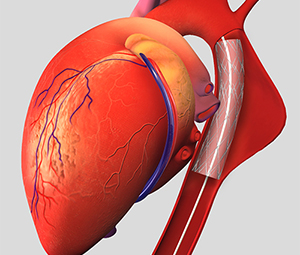Thoracic Aortic Aneurysm Endovascular Repair
 The aorta, the largest artery in the body, transfers blood from the heart to the entire body. The thoracic aorta is the part of the aorta that runs down your chest. Thoracic aortic aneurysm is the bulging of the walls due at a weak area of the thoracic aorta. The bulging may further burst, causing bleeding, and shock or death. Thoracic aneurysm is treated with surgical repair.
The aorta, the largest artery in the body, transfers blood from the heart to the entire body. The thoracic aorta is the part of the aorta that runs down your chest. Thoracic aortic aneurysm is the bulging of the walls due at a weak area of the thoracic aorta. The bulging may further burst, causing bleeding, and shock or death. Thoracic aneurysm is treated with surgical repair.
Your doctor may decide to repair the thoracic aneurysm based on various factors. They include:
- Growth of aneurysm more than 1 cm per year
- Symptoms of aortic dissection (severe tearing pain in chest or back)
- Chest, back, jaw and neck pain
- Size of aneurysm based on the individuals height
Thoracic aneurysm can be repaired with an open surgery or an endovascular stent-graft.
Open surgery: Your doctor makes an incision in the chest to replace the weak part of the thoracic aorta. The incision depends on the location of the thoracic aneurysm. The incision is made in the front of the chest if the aneurysm is in the aortic arch. The incision is made on the left side of your chest for an aneurysm in the descending thoracic aorta. Your surgeon then replaces the weak part of the thoracic aorta with a graft. The graft is stronger than the aorta and supports it, allowing blood to flow seamlessly.
Endovascular Stent Graft Repair: Endovascular repair involves inserting a catheter through a blood vessel in the groin or arm which is guided to the site of the aneurysm. This is performed under the guidance of X-ray images. The stent-graft is placed at the site of the aneurysm through the catheter. This allows blood to flow easily through the aorta and relieves pressure on the weak walls of the thoracic aorta. This procedure is feasible only if the aneurysm has a suitable shape for effective placement of stent.
Post-operative Care
Following the repair, you may have a short hospital stay (2 to 3 days) and quicker recovery with endovascular repair compared to open surgery (7 to 10 days). Recovery may take 2 to 3 months in case of complex aneurysm or other heart, lung or kidney diseases. Follow-up imaging tests may be ordered to ensure proper functioning of the stent with regard to endovascular repair. You will be instructed to follow healthy lifestyle to avoid further complications.
Risks & Complications
As with any procedure, thoracic aneurysm repair involves certain risks and complications. They include:
- Bleeding and graft infection
- Heart attack
- Irregular heart rhythm
- Paralysis
- Stroke
- Kidney damage







